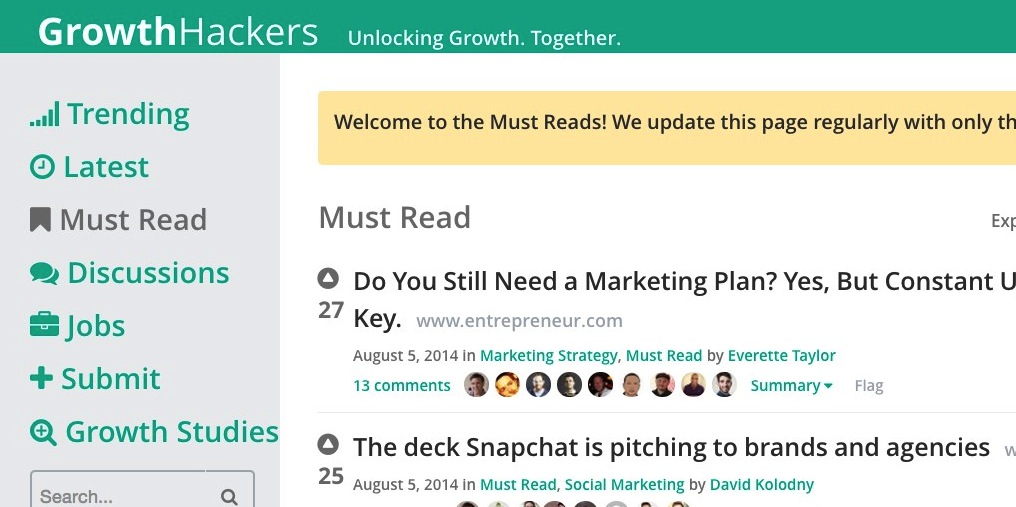When a startup like Harrys.com launches with an outreach campaign that that gets 85K potential customers to share their email address, people are impressed.

When the cofounder of that company writes a 3,700 word explanation of what they did to achieve those results, and then posts it on one of America’s most popular business blogs so that other marketers can learn from their experience, people are even more impressed.
Sharing the details of your company’s successful product launch is a profoundly generous act, because it aims to help other businesses do better themselves.
As Jeff Raider, Co-Founder and Co-CEO of Harry’s writes:
While it’s very difficult to attribute (our launch’s) success to one specific variable — the code, the tactics, the idea — we thought we’d share our story in the hopes it might help you with your future endeavors. We have no doubt that you can tweak and improve this early experiment, and we look forward to learning from your future successes.
Impressive sharing, yes. But even an act this generous has a constrained impact.
While a popular blog might get the launch information out to many different business readers, the blog isn’t necessarily targeted to the right audience. Who knows how many readers of FourHourWorkWeek are involved in online marketing and able to benefit from this kind of detailed information?
And, while readers can interact with the author by commenting on the post, they don’t have a sense of who the other commenters are, they don’t establish a connection with each other, and they don’t build on a body of previous knowledge.
To be sure, it’s terrifically generous to share business information in any forum, so why be picky about when and how that sharing happens?
Because paying attention to the structure of the forum where you share information can profoundly expand the impact of your business’s generosity.
Can You Accelerate, Scale, and Amplify the Impact of Your Business’s Generosity?
Imagine if, instead of sharing in a single blog post sent to a general business audience, Harrys had shared their experiences in an online community of marketing innovators?
What if businesses were able to read and respond to what Harrys shared, in ways that encouraged additional sharing?
What kind any business had a way of sharing that could help to accelerate, amplify, and scale the impact of their business’s generosity?
Enter GrowthHackers.com, a social sharing site where marketers, founders, and product-people can share and discuss ideas and tactics for digital marketing.
![]()
GrowthHackers.com is a community to learn and share about ethical online marketing techniques that drive effective, scalable and sustainable growth.
Because GrowthHackers.com has built a web platform specifically for sharing experiences, references and tactics, they’ve made it easier for companies to be generous and to have a broader positive impact.
GrowthHacker’s website platform is built along the same model as more broadly defined social networking and news sites like Reddit and HackerNews. GrowthHackers.com is open (anyone can participate), public (anyone can see it), easy to use, simple, and free.
Make Sharing Easy

The structure of the site itself makes each contribution by an individual available to the whole community. When people share on the site, it’s not a two-sided transaction like in an email exchange or even a blog post with comments.
The community structure, where anyone reads, anyone comments, and anyone recommends an article in full view of other members, makes each contribution to GrowthHackers.com a multi-pronged, one-to-many form of sharing.
Invite Personal Contribution
Participants don’t just add an article to the site— they’re asked to summarize and comment on articles they share, to help other users get a sense of why the article was submitted and how the article might be valuable. This first level of commentary helps to pull the highlights and aha’s out of an article.
Built-in features of the platform, like tabs for “Trending” and “Must Read” articles as well as the ability to vote on posts that are especially helpful, work to curate the collection in real time and maximize the possibility that information will ultimately get to the businesses who can use it.
Circumvent Constraints of 1:1 Reciprocity
One-to-one reciprocity seems like a good idea, but transactional expectations about direct reciprocity can actually inhibit sharing.
With a structure like GrowthHackers.com’s, the expectation of a ‘quid pro quo’ is replaced with a ‘pay it forward’ attitude.
On GrowthHackers.com, people can be generous without needing to worry about direct reciprocity. The don’t need to find a specific partner to exchange with, they don’t have to wait until they have something to give in order to ask for help, and there is no price for participating. You don’t even have to be an expert to contribute effectively; you can contribute by asking a good question in the “Ask GH” forum.
Align Incentives
The design of the website aligns the incentives of participants so that they work with each other. There is no competition set up between participants and no explicit reputation or grading scheme to evaluate contributors. Despite the presence of some high profile founders everyone participates as an equal.
To influence the quality of what’s shared as an article and in discussions, the site relies on each participant’s professionalism. For many of the online marketers at companies with low public profiles, as well as for individuals with no public platform of their own, GrowthHackers.com becomes a platform for building a public reputation and for making connections among a group of professional peers.
As for evaluating content, the site relies on the ‘law of two feet’. If an article is useful, people will read it, comment on it and recommend it, moving the article higher up on the ‘trending’ page. If an article isn’t immediately popular, it remains available through the search feature for when someone realizes they might need it. (I was able to discover some inside scoop on companies I’ve been following, just by searching for them on the site.)
Encourage Quality & Responsibility
To encourage generosity and improve the quality of new ideas, GrowthHackers.com has built in a set of rules that shape how the community interacts. These rules include directions for how to submit a contribution, how to summarize an article, and how to link the article back to its original source.
The requirement that contributors participate as ‘real people’ and not with avatars or pseudonyms encourages professional, helpful interactions rather than mean or dismissive comments. Contributors have a chance to show off their individual insights and expertise, but only in the context of helping others use the information that they or someone else has shared. Even though these are ‘rules’, they feel both sensible and light. It’s no burden to follow them.
Why GrowthHackers.com Matters So Much to Growth Hacking Practice
Growth hacking is an emerging set of marketing practices designed to to reach new customers with tactics that take advantage of the features and low costs of digital media. Digital startups in particular have been advancing growth hacking practice largely through aggressive trial and error.

As Sean Ellis, the marketer who coined the term ‘growth hacking’ explains, it’s “resource-constrained desperation” that leads startups to innovate outside of traditional marketing tactics and to experiment relentlessly.
There is, as yet, no body of ‘best practices’ or general knowledge from which to learn growth hacking. Instead, startups are learning by doing, using experiments, prototyping and a/b testing to figure out each next step.
What’s actually being learned is hard to track from anywhere but the inside. Insiders see each action, the hypotheses that lead to the action, and the outcome data the action generates. They learn from analyzing all three together.
In contrast, outsiders see only the external actions, which makes it hard to to draw conclusions about what actions to borrow or how to reverse engineer any growth hacking success. The only way growth hackers can learn faster than the pace of their own experience is to share ideas with other growth hackers.
A sharing community like GrowthHackers.com encourages businesses to share their tactics and data by making sharing easy, and makes their generosity feel worthwhile by amplifying its reach.
Where did GrowthHackers.com Come From?
Although the GrowthHackers.com website has no visible sponsor, it only takes a few clicks to the bottom of their About page to discover that they’re owned by a for-profit company, Qualaroo. Qualaroo is a software-as-service provider that helps customers understand how visitors move through their sites and figure out how to ‘convert’ them into paying customers. In other words, Qualaroo helps track one kind of data that growth hackers use.
But why did Qualaroo build and launch GrowthHackers.com? To some degree, GrowthHackers.com was designed to give Qualaroo and their clients access to the latest in digital marketing practice. Qualaroo CEO Sean Ellis (yes, the same fellow) explains that GrowthHackers.com was intended to “re-imagine how we learn marketing”.
But if Qualaroo’s goal was to create a place for themselves and their client companies to learn, why would they make this site open and public so that any company could learn?
Ellis had begun to realize that if Qualaroo remained focused on customer behavior within each client’s site, his company’s growth would be healthy but incremental. Meanwhile, the growth hacking tools and techniques themselves had unlimited potential to help clients grow. If these tools were “the seeds of something that could really be transformative in marketing”, GrowthHackers.com could be the place where these tools and skills came together to help redefine marketing itself.
Where is GrowthHackers.com Going?
GrowthHackers.com is now the go-to source for tools, tactics, skill sets and standards for growth hacking. What GrowthHackers.com becomes as it grows even larger is an open question.
In an interview on EntrepreneurOnFire.com (17:00-18:30), Ellis hints at plans to ‘connect the dots’ between the site and Qualaroo’s businesses more directly. It seems likely that the current connection between the two will expand from being learning-focused to including additional revenue streams from GrowthHackers.com to Qualaroo.
It’s important to highlight that expanding the flow of value to include both $$ revenue and qualitative value would not cheapen the connection or make GrowthHackers.com any less a contribution to the startup community.
Instead, it would demonstrate yet again that a company can grow by being generous.


 I am an organizational consultant, change advocate, and organizational identity/reputation scholar with a PhD in leadership & organizations. I research, write about, and consult with organizations on the relationships between organizational identity, actions, and purpose. I teach Technology Management, part-time, at Stevens Institute of Technology.
My current research focuses on how social technologies in the workplace can drive organizational change, generate meaning, and catalyze purpose. See the
I am an organizational consultant, change advocate, and organizational identity/reputation scholar with a PhD in leadership & organizations. I research, write about, and consult with organizations on the relationships between organizational identity, actions, and purpose. I teach Technology Management, part-time, at Stevens Institute of Technology.
My current research focuses on how social technologies in the workplace can drive organizational change, generate meaning, and catalyze purpose. See the 
{ 3 comments }
You have no real idea how targeted those leads
are. Email, direct mail, phone calls, in-person sales,
samples, testing services, etc. You can also post
links that will connect to other social networking sites like Twitter too.
The leaves wilt easily, so it needs a daily watering and moist environment.
Install a little water fountain on top of the fireplace to soothe the fire energy.
Among the items used for decorating the garden that has not been affected by
changing times and tastes.
Outline below are broad rules that would increase the ranking of your website on search engines and
its visibility:. It is necessary for you to report any type of black hat
search engine optimization in case you remember that your competitors are using these hoax to make their websites rank higher
in the search engine. It’s important to use
simple, text only, links when building the navigation for the site.
Comments on this entry are closed.
{ 1 trackback }